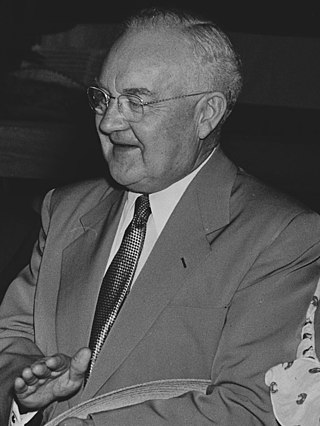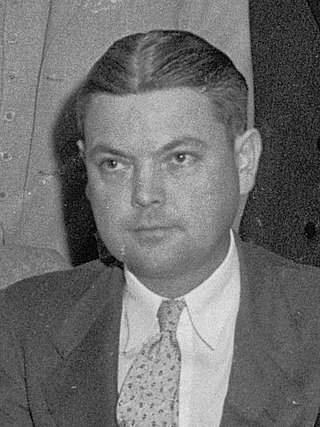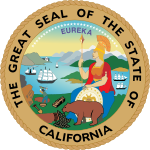A recall election is a procedure by which, in certain polities, voters can remove an elected official from office through a referendum before that official's term of office has ended. Recalls appear in the constitution in ancient Athenian democracy. Even where they are legally available, recall elections are only commonly held in a small number of countries including Peru, Ecuador, and Japan. They are considered by groups such as ACE Electoral Knowledge Network as the most rarely used form of direct democracy.

Charles Norris Poulson was an American politician who represented Southern California in public office at the local, state, and federal levels. He served as the 36th Mayor of Los Angeles from 1953 to 1961, after having been a California State Assemblyman and then a member of the United States Congress. He was a Republican.

John Clinton Porter was a U.S. political figure. The Los Angeles Times wrote that he represented a "unique mixture of reform politics and xenophobic Protestant populism [that] took him quite literally from the junk yard to City Hall." Porter was a member of the Ku Klux Klan during its popular resurgence in the early 1920s.

The Los Angeles City Council is the lawmaking body for the city government of Los Angeles, California, the second largest city in the United States. It has 15 members who each represent the 15 city council districts that are spread throughout the cities 501 square miles of land.

Frank Lawrence Shaw was the first mayor of a major American city to be recalled from office, in 1938. He was also a member of the Los Angeles City Council and then the Los Angeles County Board of Supervisors. His administration was seen as one of the most corrupt in Los Angeles history, although he had some defenders and was never charged officially with any crime.

Fletcher Bowron was an American lawyer, judge, and politician. He was the 35th Mayor of Los Angeles from 1938 to 1953. A member of the Republican Party, he was at the time the city's longest-serving mayor and was the city's second longest-serving mayor overall after Tom Bradley, presiding over the war boom and very heavy population growth, and building freeways to handle them.

James Edgar Davis was an American police officer who served as the chief of the Los Angeles Police Department (LAPD) from 1926 to 1929, and from 1933 to 1939. During his first term as LAPD chief, Davis emphasized firearms training. Under Davis, the LAPD developed its lasting reputation as an organization that relied on brute force to enforce public order. It also became publicly entangled in corruption. Members of the LAPD were revealed to have undertaken a campaign of brutal harassment, including the bombings of political reformers who had incurred the wrath of the department and the civic administration.

Winfred Joseph Sanborn was on the Los Angeles City Council under an at-large election system from 1919 until a new city charter was adopted in 1925, when representation was changed to a fifteen-district system. Sanborn served the new Ninth District from 1925 until 1931, and then, when Councilman Howard E. Dorsey was killed in a motor accident in 1937, he was appointed to serve two more years.

John C. Holland was one of the longest-serving Los Angeles City Council members, for 24 years from 1943 to 1967, and was known for his losing fight against bringing the Los Angeles Dodgers to Chavez Ravine and for his reputation as a watchdog over the city treasury.
Employers Group was founded as the Merchants and Manufacturers Association (M&M) in 1896 in California. It has become a worldwide organization advocating for employers and giving guidance about employment laws and regulations, professional development, consulting projects, and compensation and workplace trends surveys.

Kent Kane Parrot was an American political figure and attorney who was considered the "boss" of municipal politics in Los Angeles, California, in the 1920s.

Earl C. Gay (1902–1972) was a registered pharmacist who was a member of the Los Angeles City Council between 1933 and 1945.

The 1933 Los Angeles mayoral election took place on May 2, 1933, with a run-off election on June 6, 1933. Incumbent John Clinton Porter was defeated by Frank L. Shaw, a Los Angeles County Supervisor, in the runoff election. During the election, Shaw's citizenship was questions as his birth records could not be located.

The 1937 Los Angeles mayoral election took place on April 6, 1937, with a runoff election on May 4, 1937. Incumbent Frank L. Shaw was reelected over Supervisor John Anson Ford in the runoff election.

The 1941 Los Angeles mayoral election took place on April 1, 1941, with a run-off election on May 6, 1941. Incumbent Fletcher Bowron was re-elected in the runoff election, defeating councilmember Stephen W. Cunningham.

The 1945 Los Angeles mayoral election took place on April 3, 1945. Incumbent Fletcher Bowron was re-elected outright with minimal opposition. The candidates challenging Bowron included restaurateur Clifford Clinton, city councilmember Ira J. McDonald, and former State Assemblymember Sam Yorty.

The 1949 Los Angeles mayoral election took place on April 5, 1949, with a run-off election on May 31, 1949. Incumbent Fletcher Bowron was re-elected.

The 1953 Los Angeles mayoral election took place on April 7, 1953, with a run-off election on May 26, 1953. Incumbent Fletcher Bowron was defeated by Norris Poulson, a U.S. Representative.

Carl Bernardino Wirsching was an American engineer, veteran, and politician who was active in Los Angeles in the 1930s and 1940s. After serving in the United States Army as a part of the American Expeditionary Forces in France, he returned to Los Angeles to pursue political activities, running in the 1937 Los Angeles mayoral election and placing fourth in the primary.
















